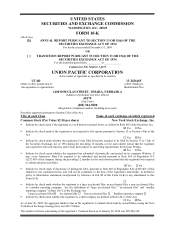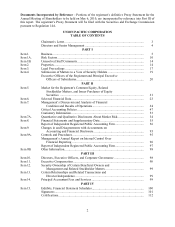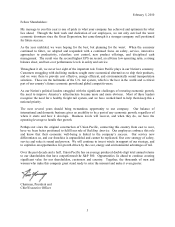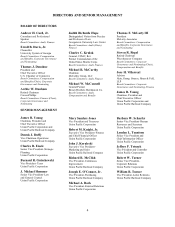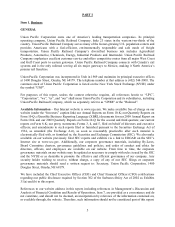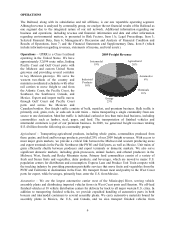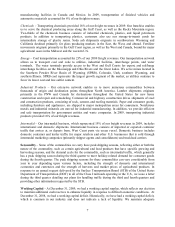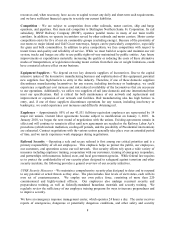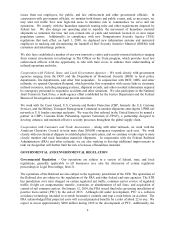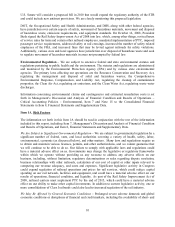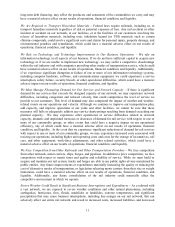Union Pacific 2009 Annual Report Download
Download and view the complete annual report
Please find the complete 2009 Union Pacific annual report below. You can navigate through the pages in the report by either clicking on the pages listed below, or by using the keyword search tool below to find specific information within the annual report.
`
UNITED STATES
SECURITIES AND EXCHANGE COMMISSION
WASHINGTON, D.C. 20549
FORM 10-K
(Mark One)
[X] ANNUAL REPORT PURSUANT TO SECTION 13 OR 15(d) OF THE
SECURITIES EXCHANGE ACT OF 1934
For the fiscal year ended December 31, 2009
OR
[ ] TRANSITION REPORT PURSUANT TO SECTION 13 OR 15(d) OF THE
SECURITIES EXCHANGE ACT OF 1934
For the transition period from __________ to ____________
Commission File Number 1-6075
UNION PACIFIC CORPORATION
(Exact name of registrant as specified in its charter)
UTAH 13-2626465
(State or other jurisdiction of (I.R.S. Employer
incorporation or organization) Identification No.)
1400 DOUGLAS STREET, OMAHA, NEBRASKA
(Address of principal executive offices)
68179
(Zip Code)
(402) 544-5000
(Registrant’ s telephone number, including area code)
Securities registered pursuant to Section 12(b) of the Act:
Title of each Class
Common Stock (Par Value $2.50 per share)
Name of each exchange on which registered
New York Stock Exchange, Inc.
Indicate by check mark if the registrant is a well-known seasoned issuer, as defined in Rule 405 of the Securities Act.
Yes No
Indicate by check mark if the registrant is not required to file reports pursuant to Section 13 or Section 15(d) of the
Act.
Yes No
Indicate by check mark whether the registrant (1) has filed all reports required to be filed by Section 13 or 15(d) of
the Securities Exchange Act of 1934 during the preceding 12 months (or for such shorter period that the registrant
was required to file such reports), and (2) has been subject to such filing requirements for the past 90 days.
Yes No
Indicate by check mark whether the registrant has submitted electronically and posted on its corporate Website, if
any, every Interactive Data File required to be submitted and posted pursuant to Rule 405 of Regulation S-T
(§232.405 of this chapter) during the preceding 12 months (or for such shorter period that the registrant was required
to submit and post such files).
Yes No
Indicate by check mark if disclosure of delinquent filers pursuant to Item 405 of Regulation S-K (§229.405 of this
chapter) is not contained herein, and will not be contained, to the best of the registrant’ s knowledge, in definitive
proxy or information statements incorporated by reference in Part III of this Form 10-K or any amendment to this
Form 10-K.
Indicate by check mark whether the registrant is a large accelerated filer, an accelerated filer, a non-accelerated filer,
or a smaller reporting company. See the definitions of “large accelerated filer,” “accelerated filer” and “smaller
reporting company” in Rule 12b-2 of the Exchange Act.
Large accelerated filer Accelerated filer Non-accelerated filer Smaller reporting company
Indicate by check mark whether the registrant is a shell company (as defined in Rule 12b-2 of the Act).
Yes No
As of June 30, 2009, the aggregate market value of the registrant’ s Common Stock held by non-affiliates (using the New
York Stock Exchange closing price) was $28.7 billion.
The number of shares outstanding of the registrant’ s Common Stock as of January 29, 2010 was 505,286,368.
Table of contents
-
Page 1
... Identification No.) (Address of principal executive offices) 1400 DOUGLAS STREET, OMAHA, NEBRASKA 68179 (Zip Code) (402) 544-5000 (Registrant' s telephone number, including area code) Securities registered pursuant to Section 12(b) of the Act: Title of each Class Common Stock (Par Value $2.50... -
Page 2
... ...Controls and Procedures...Management' s Annual Report on Internal Control Over Financial Reporting ...Report of Independent Registered Public Accounting Firm...Other Information ...PART III Directors, Executive Officers, and Corporate Governance ...Executive Compensation ...Security Ownership of... -
Page 3
... will continue to invest wisely in support of our strategy, and to capitalize on opportunities for growth driven by the cost, energy and environmental advantages of rail. Over the past decade and a half, Union Pacific has on average produced double-digit total annual returns to our shareholders that... -
Page 4
..., Compensation and Benefits Archie W. Dunham Retired Chairman ConocoPhillips Board Committees: Finance (Chair), Corporate Governance and Nominating James R. Young Chairman, President and Chief Executive Officer Union Pacific Corporation and Union Pacific Railroad Company SENIOR MANAGEMENT James... -
Page 5
... mode of freight transportation. Union Pacific Railroad Company' s diversified business mix includes Agricultural Products, Automotive, Chemicals, Energy, Industrial Products and Intermodal. Union Pacific Railroad Company emphasizes excellent customer service and offers competitive routes from all... -
Page 6
... and Supplementary Data, Item 8 (which include information regarding revenues, statements of income, and total assets). Operations - UPRR is a Class I railroad 2009 Freight Revenue operating in the United States. We have Agricultural Intermodal approximately 32,094 route miles, linking 20% 19... -
Page 7
... prices of agricultural products. In response to an annual request delivered by the Surface Transportation Board (STB) of the United States Department of Transportation (DOT) to all of the Class I railroads operating in the U.S., we issue a letter during the third quarter detailing our plans for... -
Page 8
... materials and security training. We regularly review the sufficiency of our employee training programs for ways to increase preparedness and to improve security. We have an emergency response management center, which operates 24 hours a day. The center receives reports of emergencies, dangerous or... -
Page 9
... imposed by federal law. We also design our operating plan to expedite the movement of hazardous material shipments to minimize the time rail cars remain idle at yards and terminals located in or near major population centers. Additionally, in compliance with new Transportation Security Agency (TSA... -
Page 10
... other capital investments. In addition to current legislative activity, one or more consolidations of Class I railroads could also lead to increased regulation of the rail industry. We May Be Affected by General Economic Conditions - Prolonged severe adverse domestic and global economic conditions... -
Page 11
... storage of locomotives, rail cars, and other equipment; work-force adjustments; and other related activities, which could have a material adverse effect on our results of operations, financial condition, and liquidity. We Face Competition from Other Railroads and Other Transportation Providers - We... -
Page 12
... Strikes or Work Stoppages Could Adversely Affect Our Operations as the Majority of Our Employees Belong to Labor Unions and Labor Agreements - The U.S. Class I railroads are party to collective bargaining agreements with various labor unions. Disputes with regard to the terms of these agreements or... -
Page 13
...utilizing a sale of receivables program and issuing both commercial paper and long-term debt. We Are Subject to Legislative, Regulatory, and Legal Developments Involving Taxes - Taxes are a significant part of our expenses. We are subject to U.S. federal, state, and foreign income, payroll, property... -
Page 14
... dramatically, or certain coverages may not be available to us in the future. Item 1B. Unresolved Staff Comments None. Item 2. Properties We employ a variety of assets in the management and operation of our rail business. Our rail network covers 23 states in the western two-thirds of the U.S. 14 -
Page 15
...200 1,000 1,200 900 1,000 Top 10 Classification Yards North Platte, Nebraska North Little Rock, Arkansas Englewood (Houston), Texas Proviso (Chicago), Illinois Fort Worth, Texas Roseville, California Livonia, Louisiana West Colton, California Pine Bluff, Arkansas Neff (Kansas City), Missouri 15 -
Page 16
... 10 Intermodal Terminals ICTF (Los Angeles), California East Los Angeles, California Global I (Chicago), Illinois Global II (Chicago), Illinois Marion (Memphis), Tennessee City of Industry (Los Angeles), California Lathrop (Stockton), California Dallas, Texas Oakland, California Yard Center (Chicago... -
Page 17
... if business conditions or new laws or regulations affect our ability to generate sufficient returns on these investments. See discussion of our 2010 capital plan in Management' s Discussion and Analysis of Financial Condition and Results of Operations - 2010 Outlook, Item 7. Equipment Encumbrance... -
Page 18
... in our Annual Report on Form 10-K for 2008, the Colorado Department of Public Health and Environment issued a Notice of Violation/Cease and Desist Order to the Railroad on April 26, 2007, involving certain alleged violations of the Railroad' s stormwater permits at its Burnham Shops and North Yard... -
Page 19
... Florida, Illinois, Alabama, Pennsylvania, and the District of Columbia. These suits allege that the named railroads engaged in pricefixing by establishing common fuel surcharges for certain rail traffic. We received additional complaints following the initial claim, increasing the total number... -
Page 20
... - Law and General Counsel 60 of UPC and the Railroad Senior Vice President - Human Resources and Secretary of UPC and the Railroad 56 Vice President and Controller of UPC and Chief 51 Accounting Officer and Controller of the Railroad Vice Chairman - Operations of the Railroad Executive Vice... -
Page 21
... of this restriction in Management' s Discussion and Analysis of Financial Condition and Results of Operations - Liquidity and Capital Resources, Item 7. We do not believe the restriction on retained earnings will affect our ability to pay dividends, and we currently expect to pay dividends in 2010... -
Page 22
... equity compensation arrangements. The following table presents common stock repurchases during each month for the fourth quarter of 2009: Total Number of Shares Maximum Number of Purchased as Part of a Shares That May Yet Be Publicly Announced Purchased Under the Plan or Program [b] Plan or Program... -
Page 23
...equity Equity per common share [d] Additional Data Freight revenues [b] Revenue carloads (units) (000) Operating margin (%) [e] Operating ratio (%) [e] Average employees (000) Operating revenues per employee (000) Financial Ratios (%) Debt to capital [f] Return on average common shareholders' equity... -
Page 24
... velocity, average terminal dwell, freight car utilization and service delivery. Lower volume levels, network management initiatives, and efforts to improve asset utilization were key drivers of our operational improvement. We increased average train speed by 16% and improved car utilization by... -
Page 25
... railroad benefits our employees, our customers, our shareholders, and the public. We will continue using a multi-faceted approach to safety, utilizing technology, risk assessment, quality control, and training, and by engaging our employees. We will continue implementing Total Safety Culture (TSC... -
Page 26
... customers through our fuel surcharge programs and to expand our fuel conservation efforts. Capital Plan - In 2010, we plan to make total capital investments of approximately $2.5 billion, including expenditures for PTC, which may be revised if business conditions or new laws or regulations affect... -
Page 27
... we moved fewer intermodal, automotive, industrial products, and chemical shipments, which more than offset volume growth from agricultural and energy shipments. Our fuel surcharge programs (excluding index-based contract escalators that contain some provision for fuel) generated freight revenues of... -
Page 28
... 2008. 2009 Agricultural Revenue Grain Products 41% Food/ Refrigerated 24% Price improvements, fuel surcharges, and Whole Grains 35% volume growth generated higher agricultural freight revenue in 2008 versus 2007. Strong global demand for grain and a weak dollar drove higher shipments of corn and... -
Page 29
... program' s benefits. Double-digit declines in shipments of both finished vehicles and auto parts drove freight revenue lower in 2008 compared to 2007. Price improvements and fuel surcharges partially offset these lower volumes. The manufacturers experienced poor sales and reduced vehicle production... -
Page 30
... and network interruptions caused by extensive flooding in the Midwest in June of 2008. Conversely, shipments from the Colorado and Utah mines were down 4% in 2008 versus 2007, due to mine production problems. Industrial Products - Reduced volume 2009 Industrial Products Revenue and fuel surcharges... -
Page 31
... - Decreased volumes and fuel 2009 Intermodal Revenue surcharges reduced freight revenue from intermodal shipments in 2009 versus 2008. Volume from international traffic Domestic decreased 24% in 2009 compared to 2008, 49% reflecting economic conditions, continued weak imports from Asia, and... -
Page 32
...in our fuel consumption rate resulted in $136 million of cost savings due to the use of newer, more fuel efficient locomotives; our fuel conservation programs; improved network operations; and a shift in commodity mix, primarily due to growth in bulk shipments. Volume, as measured by gross ton-miles... -
Page 33
...rental expense that the Railroad pays for freight cars owned by other railroads or private companies; freight car, intermodal, and locomotive leases; other specialty equipment leases; and office and other rentals. Fewer shipments of industrial products and intermodal containers primarily contributed... -
Page 34
... due to higher gains from real estate sales, which included the $116 million pre-tax gain from a land sale to the Regional Transportation District (RTD) in Colorado and lower interest expense on our sale of receivables program, resulting from lower interest rates and a lower outstanding balance... -
Page 35
... pt (2.0) pt (10)% (4)% 5 pt 4 pt Average train speed (miles per hour) Average terminal dwell time (hours) Average rail car inventory (thousands) Gross ton-miles (billions) Revenue ton-miles (billions) Operating ratio Employees (average) Customer satisfaction index 2009 27.3 24.8 283.1 846.5 479... -
Page 36
..., Except Percentages Net income Average equity Return on average common shareholders' equity Return on Invested Capital as Adjusted (ROIC) Millions of Dollars, Except Percentages Net income Add: Interest expense Add: Sale of receivables fees Add: Interest on present value of operating leases Less... -
Page 37
... management and investors in evaluating the total amount of leverage in our capital structure, including off-balance sheet lease obligations, which we generally incur in connection with financing the acquisition of locomotives and freight cars and certain facilities. Operating leases were discounted... -
Page 38
... outstanding balance of our accounts receivable securitization program, higher pension contributions of $72 million, and changes to working capital combined to decrease cash provided by operating activities compared to 2008. Higher net income and changes in working capital combined to increase cash... -
Page 39
... rail capacity expansion New ties installed (thousands) Miles of track surfaced Capital Plan - In 2010, we expect our total capital investments to be approximately $2.5 billion, which may be revised if business conditions or new laws or regulations affect our ability to generate sufficient returns... -
Page 40
... we were in compliance with this covenant. The definition of debt used for purposes of calculating the debt-to-net-worth coverage ratio includes, among other things, certain credit arrangements, capital leases, guarantees and unfunded and vested pension benefits under Title IV of ERISA. At December... -
Page 41
... of our common stock under this program in 2010, we expect to fund such repurchases through cash generated from operations, the sale or lease of various operating and non-operating properties, debt issuances, and cash on hand. Shelf Registration Statement and Significant New Borrowings - Under our... -
Page 42
... into a capital lease agreement for 44 locomotives with a total equipment cost of $100 million. The lessor purchased the 44 locomotives from the Corporation and subsequently leased the locomotives back to the Railroad. These capital lease obligations are reported in our Consolidated Statements of... -
Page 43
...related to our headquarters building, equipment financings, and affiliated operations. None of the letters of credit were drawn upon as of December 31, 2009. Off-Balance Sheet Arrangements Sale of Receivables - The Railroad transfers most of its accounts receivable to Union Pacific Receivables, Inc... -
Page 44
..., futures, and/or forward contracts to mitigate the risk of adverse movements in interest rates and fuel prices; however, the use of these derivative financial instruments may limit future benefits from favorable price movements. Market and Credit Risk - We address market risk related to derivative... -
Page 45
... Derivatives and Hedging Topic of the Financial Accounting Standards Board (FASB) Accounting Standards Codification (ASC); therefore, we do not record any ineffectiveness within our Consolidated Financial Statements. Interest Rate Cash Flow Hedges - We report changes in the fair value of cash flow... -
Page 46
...and reporting standards. All other nongrandfathered non-SEC accounting literature not included in the Codification became nonauthoritative. FAS 168 was effective for financial statements issued for interim and annual periods ending after September 15, 2009. The adoption of FAS 168 did not affect our... -
Page 47
...the impact of our operations on the environment, including investments in new technologies, using training programs to reduce fuel consumption, and changing our operations to increase fuel efficiency. CRITICAL ACCOUNTING POLICIES Our Consolidated Financial Statements have been prepared in accordance... -
Page 48
...186 2007 $ 631 165 (203) $ $ 593 204 Open claims, beginning balance New claims Settled or dismissed claims Open claims, ending balance at December 31 Asbestos - We are a defendant in a number of lawsuits in which current and former employees and other parties allege exposure to asbestos. We engage... -
Page 49
... were based on currently known facts. However, future events, such as the number of new claims to be filed each year, average settlement costs, and insurance coverage issues, could cause the actual costs and insurance recoveries to be higher or lower than the projected amounts. Estimates also may... -
Page 50
... program for the replacement of assets and for the acquisition or construction of assets that enable us to enhance our operations or provide new service offerings to customers. Assets purchased or constructed throughout the year are capitalized if they meet applicable minimum units of property... -
Page 51
... corridors, we calculate depreciation rates annually by dividing the number of gross ton-miles carried over the rail (i.e., the weight of loaded and empty freight cars, locomotives and maintenance of way equipment transported over the rail) by the estimated service lives of the rail measured in... -
Page 52
... with each asset class to ensure our depreciation rates are appropriate. For retirements of depreciable railroad properties that do not occur in the normal course of business, a gain or loss may be recognized if the retirement meets each of the following three conditions: (i) is unusual, (ii... -
Page 53
... of Dollars 0.25% decrease in discount rate 0.25% increase in salary scale 0.25% decrease in expected return on plan assets 1% increase in healthcare cost trend rate CAUTIONARY INFORMATION Certain statements in this report, and statements in other reports or information filed or to be filed with... -
Page 54
... (and, therefore, such forward-looking statements and information) are or may be subject to variables or unknown or unforeseeable events or circumstances over which management has little or no influence or control. The Risk Factors in Item 1A of this report could affect our future results and could... -
Page 55
Item 8. Financial Statements and Supplementary Data Index to Consolidated Financial Statements Page Report of Independent Registered Public Accounting Firm...56 Consolidated Statements of Income For the Years Ended December 31, 2009, 2008, and 2007...57 Consolidated Statements of Financial Position... -
Page 56
... financial statements taken as a whole, presents fairly, in all material respects, the information set forth therein. We have also audited, in accordance with the standards of the Public Company Accounting Oversight Board (United States), the Corporation' s internal control over financial reporting... -
Page 57
... OF INCOME Union Pacific Corporation and Subsidiary Companies Millions, Except Per Share Amounts, for the Years Ended December 31, Operating revenues: Freight revenues Other revenues Total operating revenues Operating expenses: Compensation and benefits Fuel Purchased services and materials... -
Page 58
... Current deferred income taxes (Note 7) Other current assets Total current assets Investments Net properties (Note 10) Other assets Total assets Liabilities and Common Shareholders' Equity Current liabilities: Accounts payable and other current liabilities (Note 11) Debt due within one year (Note... -
Page 59
... Other current assets Accounts payable and other current liabilities Cash provided by operating activities Investing Activities Capital investments Proceeds from asset sales Acquisition of equipment pending financing Proceeds from sale of assets financed Other investing activities, net Cash used in... -
Page 60
... IN COMMON SHAREHOLDERS' EQUITY Union Pacific Corporation and Subsidiary Companies Millions of Dollars Thousands of Shares Balance at January 1, 2007 (Note 3) Comprehensive income: Net income Other comp. income Total comp. income (Note 9) Conversion, stock option exercises, forfeitures, and... -
Page 61
... subsidiaries, including Union Pacific Railroad Company, which will be separately referred to herein as "UPRR" or the "Railroad". 1. Nature of Operations Operations and Segmentation - We are a Class I railroad that operates in the United States. We have 32,094 route miles, linking Pacific Coast and... -
Page 62
... and investments in companies (less than 20% owned) accounted for under the cost method of accounting. Materials and Supplies - Materials and supplies are carried at the lower of average cost or market. Property and Depreciation - See Note 10. Impairment of Long-lived Assets - We review long-lived... -
Page 63
... tax Total stock-based compensation, after tax Excess tax benefits from equity compensation plans 2009 $ 19 39 $ $ $ 58 36 10 2008 $ $ $ $ 25 40 65 40 54 $ $ $ $ 21 23 44 27 76 2007 Earnings Per Share - Basic earnings per share are calculated on the weighted-average number of common... -
Page 64
... with pensions and postretirement health benefits. In order to measure the expense associated with these benefits, we must make various assumptions including discount rates used to value certain liabilities, expected return on plan assets used to fund these expenses, salary increases, employee... -
Page 65
... stock on the date of such Board of Directors meeting, with the resulting quotient rounded up or down to the nearest 50 shares. As of December 31, 2009, 18,000 restricted shares were outstanding under the Directors Plan and 292,000 options were outstanding under the Directors Plan. The Union Pacific... -
Page 66
... a weighted-average period of 1.2 years. Additional information regarding stock option exercises appears in the table below: Millions of Dollars Intrinsic value of stock options exercised Cash received from option exercises Treasury shares repurchased for employee payroll taxes Tax benefit realized... -
Page 67
...were granted. See calculation of ROIC in Management' s Discussion and Analysis of Financial Condition and Results of Operations - Other Operating/Performance and Financial Statistics - Return on Invested Capital as Adjusted (ROIC), Item 7. Stock units awarded to selected employees under these grants... -
Page 68
...in the Union Pacific Retiree Medical Program will receive a contribution to a Health Reimbursement Account, which can be used to pay eligible out-of-pocket medical expenses. The impact of the plan amendment is reflected in the projected benefit obligation (PBO) at December 31, 2009. Funded Status We... -
Page 69
... at beginning of year Actual return on plan assets Voluntary funded pension plan contributions Other funded pension plan contributions Non-qualified plan benefit contributions Gross benefits paid Fair value of plan assets at end of year Funded status at end of year Pension 2009 $ 2,272 38 140 140... -
Page 70
...of Dollars Prior service cost (credit) Net actuarial loss Total Pension $ 4 43 $ 47 OPEB $ (44) 13 $ (31) Total $ (40) 56 $ 16 Underfunded Accumulated Benefit Obligation - The accumulated benefit obligation (ABO) is the present value of benefits earned to date, assuming no future salary growth. The... -
Page 71
... based upon the annual service cost of benefits (the actuarial cost of benefits earned during a period) and the interest cost on those liabilities, less the expected return on plan assets. The expected long-term rate of return on plan assets is applied to a calculated value of plan assets that... -
Page 72
... the years ended December 31: Pension 2009 2008 2007 6.25% 6.50% 6.00% 8.00% 8.00% 8.00% 3.50% 3.50% 3.00% N/A N/A N/A N/A N/A N/A N/A N/A N/A N/A N/A N/A OPEB 2008 6.50% N/A N/A 8.00% 10.00% 5.00% 2013 Percentages Discount rate Expected return on plan assets Salary increase Health care cost trend... -
Page 73
... 28 28 28 28 130 $ Equity securities Debt securities Real estate Commodities Total The investment strategy for pension plan assets is to maintain a broadly diversified portfolio designed to achieve our target of an average long-term rate of return of 8%. While we believe we can achieve a longterm... -
Page 74
... developed by the general partners that manage the partnerships. These valuations are based on property appraisals, application of public market multiples to private company cash flows, utilization of market transactions that provide valuation information for comparable companies, and other methods... -
Page 75
... Plan net assets: Temporary cash investments Registered investment companies U.S. government securities Corporate bonds & debentures Corporate stock Venture capital and partnerships Real estate Common trust funds Other investments Total plan net assets at fair value Other assets [a] Total plan net... -
Page 76
... $ 206 $ Real Estate 21 (9) 2 14 $ Total 239 3 (47) 25 220 $ $ In June of 2009, we completed a $118 million sale of land to the Regional Transportation District (RTD) in Colorado, resulting in a $116 million pre-tax gain. The agreement with the RTD involves a 33-mile industrial lead track in... -
Page 77
... purchase accounting transactions, and differences in capitalization methods. Deferred income tax liabilities/(assets) were comprised of the following at December 31: Millions of Dollars Net current deferred income tax asset Property State taxes, net of federal benefits Other Net long-term deferred... -
Page 78
... upon settlement. Unrecognized tax benefits are tax benefits claimed in our tax returns that do not meet these recognition and measurement standards. A reconciliation of changes in unrecognized tax benefits liabilities/(assets) from the beginning to the end of the reporting period is as follows... -
Page 79
...state tax disputes may be resolved, which could reduce unrecognized tax benefits...ended December 31: Millions of Dollars, Except Per Share Amounts Net income Weighted-average number of shares outstanding: Basic Dilutive effect of stock... 3.49 3.46 Common stock options totaling 4.6 million, 1.0 million,... -
Page 80
.../(Loss) Comprehensive income/(loss) was as follows: Millions of Dollars Net income Other comprehensive income/(loss): Defined benefit plans Foreign currency translation Derivatives Total other comprehensive income/(loss) [a] Total comprehensive income [a] $ 2009 1,898 $ 44 6 50 2008 2007 2,338... -
Page 81
... of property and equipment, as well as the weighted-average composite depreciation rate for each category: Millions of Dollars, Except Percentages As of December 31, 2009 Land Road: Rail and other track material [a] Ties Ballast Other [b] Total road Equipment: Locomotives Freight cars Work equipment... -
Page 82
... corridors, we calculate depreciation rates annually by dividing the number of gross ton-miles carried over the rail (i.e., the weight of loaded and empty freight cars, locomotives and maintenance of way equipment transported over the rail) by the estimated service lives of the rail measured in... -
Page 83
...our employees, and for track line expansion (capacity projects). Costs that are directly attributable or overhead costs that relate directly to capital projects are capitalized. Direct costs that are capitalized as part of self-constructed assets include material, labor, and work equipment. Indirect... -
Page 84
... in fuel expense from fuel derivatives Increase/(decrease) in pre-tax income 2009 $ 8 $ 8 2008 $ 1 1 $ 2 2007 $ (8) (1) $ (9) Fair Value of Debt Instruments - The fair value of our short- and long-term debt was estimated using quoted market prices, where available, or current borrowing rates. At... -
Page 85
... terms and conditions, although the capacity to sell undivided interests was reduced from $700 million to $600 million. See Note 17 to the Consolidated Financial Statements for information about recent accounting pronouncements that will have an impact on the accounting treatment of our sale... -
Page 86
...financings, 2.5% to 5.7% due through 2026 Commercial paper Floating rate term loan, due through 2013 Medium-term notes, 9.2% to 10.0% due through 2020 Mortgage bonds, 4.8% due through 2030 Other Unamortized discount Total debt [a] Less current portion Total long-term debt [a] $ $ 2009 7,277 2,061... -
Page 87
... we were in compliance with this covenant. The definition of debt used for purposes of calculating the debt-to-net-worth coverage ratio includes, among other things, certain credit arrangements, capital leases, guarantees and unfunded and vested pension benefits under Title IV of ERISA. At December... -
Page 88
... operating lease payables that were reclassified as part of our capital lease obligations. Capital lease obligations are reported in our Consolidated Statements of Financial Position as debt. On October 15, 2009, we entered into a capital lease agreement for 44 locomotives with a total equipment... -
Page 89
... claims. The Federal Employers' Liability Act (FELA) governs compensation for work-related accidents. Under FELA, damages are assessed based on a finding of fault through litigation or out-of-court settlements. We offer a comprehensive variety of services and rehabilitation programs for employees... -
Page 90
...a number of lawsuits in which current and former employees and other parties allege exposure to asbestos. We engage a third party with extensive experience in estimating resolution costs for asbestos-related claims to assist us in assessing our potential liability. This liability is updated annually... -
Page 91
... based on information available for each site, financial viability of other potentially responsible parties, and existing technology, laws, and regulations. The ultimate liability for remediation is difficult to determine because of the number of potentially responsible parties, site-specific cost... -
Page 92
..., our Board of Directors authorized the repurchase of an additional 40 million common shares by March 31, 2011. As of December 31, 2009, we have repurchased a total of $3 billion of Union Pacific Corporation common stock since the original repurchase plan was authorized. Management' s assessments... -
Page 93
...and reporting standards. All other nongrandfathered non-SEC accounting literature not included in the Codification became nonauthoritative. FAS 168 was effective for financial statements issued for interim and annual periods ending after September 15, 2009. The adoption of FAS 168 did not affect our... -
Page 94
18. Selected Quarterly Data (Unaudited) Millions of Dollars, Except Per Share Amounts 2009 Operating revenues Operating income Net income Net income per share Basic Diluted 2008 Operating revenues Operating income Net income Net income per share Basic Diluted Mar. 31 $ 3,415 672 362 0.72 0.72 Mar. ... -
Page 95
...Corporation' s management, including the Corporation' s Chief Executive Officer (CEO) and Executive Vice President - Finance and Chief Financial Officer (CFO), of the effectiveness of the design and operation of the Corporation' s disclosure controls and procedures pursuant to Exchange Act Rules 13a... -
Page 96
... reporting (as defined in Exchange Act Rules 13a-15(f) and 15d-15(f)). The Corporation' s internal control system was designed to provide reasonable assurance to the Corporation' s management and Board of Directors regarding the preparation and fair presentation of published financial statements... -
Page 97
... is to express an opinion on the Corporation's internal control over financial reporting based on our audit. We conducted our audit in accordance with the standards of the Public Company Accounting Oversight Board (United States). Those standards require that we plan and perform the audit to obtain... -
Page 98
Item 9B. Other Information None. PART III Item 10. Directors, Executive Officers, and Corporate Governance (a) Directors of Registrant. Information as to the names, ages, positions and offices with UPC, terms of office, periods of service, business experience during the past five years and certain ... -
Page 99
... Owners and Management segment of the Proxy Statement and is incorporated herein by reference. The following table summarizes the equity compensation plans under which Union Pacific Corporation common stock may be issued as of December 31, 2009. Number of securities remaining available for future... -
Page 100
... or the information required to be set forth therein is included in the Financial Statements and Supplementary Data, Item 8, or notes thereto. (3) Exhibits Exhibits are listed in the exhibit index beginning on page 103. The exhibits include management contracts, compensatory plans and arrangements... -
Page 101
... duly authorized, on this 5th day of February, 2010. UNION PACIFIC CORPORATION By /s/ James R. Young James R. Young, Chairman, President, Chief Executive Officer, and Director Pursuant to the requirements of the Securities Exchange Act of 1934, this report has been signed below, on this 5th day of... -
Page 102
..., beginning of period Charges/(reduction) to expense Net recoveries/(write-offs) Balance, end of period Allowance for doubtful accounts are presented in the Consolidated Statements of Financial Position as follows: Current Long-term Balance, end of period Accrued casualty costs: Balance, beginning... -
Page 103
... this Statement 10(a) 12 21 Form of 2010 Long Term Plan Stock Unit Agreement. Ratio of Earnings to Fixed Charges. List of the Corporation' s significant subsidiaries and their respective states of incorporation. Independent Registered Public Accounting Firm' s Consent. Powers of attorney executed by... -
Page 104
... herein by reference to Exhibit 10(d) to the Corporation' s Annual Report on Form 10-K for the year ended December 31, 2008. Supplemental Pension Plan for Officers and Managers (409A Non-Grandfathered Component) of Union Pacific Corporation and Affiliates, as amended and restated in its entirety... -
Page 105
... herein by reference to Exhibit 10(k) to the Corporation' s Annual Report on Form 10-K for the year ended December 31, 2008. Union Pacific Corporation Stock Unit Grant and Deferred Compensation Plan for the Board of Directors (409A Grandfathered Component), as amended and restated in its entirety... -
Page 106
...1995. The Executive Life Insurance Plan of UPC, as amended October 1997, is incorporated herein by reference to Exhibit 10(t) to the Corporation' s Annual Report on Form 10-K for the year ended December 31, 1997. Charitable Contribution Plan for Non-Employee Directors of Union Pacific Corporation is... -
Page 107
..., 2005. Form of Non-Qualified Stock Option Agreement for Executives is incorporated herein by reference to Exhibit 10(c) to the Corporation' s Annual Report on Form 10-K for the year ended December 31, 2005. Executive Incentive Plan (2005) - Deferred Compensation Program, dated December 21, 2005 is... -
Page 108
... TO FIXED CHARGES Union Pacific Corporation and Subsidiary Companies Millions of Dollars, Except for Ratios 2009 Fixed charges: Interest expense including amortization of debt discount $ 600 Portion of rentals representing an interest factor 155 Total fixed charges Earnings available for fixed... -
Page 109
Exhibit 21 SIGNIFICANT SUBSIDIARIES OF UNION PACIFIC CORPORATION Name of Corporation Union Pacific Railroad Company...Southern Pacific Rail Corporation...State of Incorporation Delaware Utah 109 -
Page 110
...and Subsidiary Companies (the Corporation) and the effectiveness of the Corporation' s internal control over financial reporting, appearing in this Annual Report on Form 10-K of Union Pacific Corporation and Subsidiary Companies for the year ended December 31, 2009. Omaha, Nebraska February 5, 2010... -
Page 111
... of the undersigned directors of Union Pacific Corporation, a Utah corporation (the Company), do hereby appoint each of James R. Young, Barbara W. Schaefer, and Thomas E. Whitaker his or her true and lawful attorney-in-fact and agent, to sign on his or her behalf the Company' s Annual Report on Form... -
Page 112
... information; and (b) Any fraud, whether or not material, that involves management or other employees who have a significant role in the registrant' s internal control over financial reporting. Date: February 5, 2010 /s/ James R. Young James R. Young Chairman, President and Chief Executive Officer... -
Page 113
... the design or operation of internal control over financial reporting which are reasonably likely to adversely affect the registrant' s ability to record, process, summarize and report financial information; and (b) Any fraud, whether or not material, that involves management or other employees who... -
Page 114
... Exchange Act of 1934; and (2) The information contained in the Report fairly presents, in all material respects, the financial condition and results of operations of the Corporation. By: /s/ James R. Young James R. Young Chairman, President and Chief Executive Officer Union Pacific Corporation...

